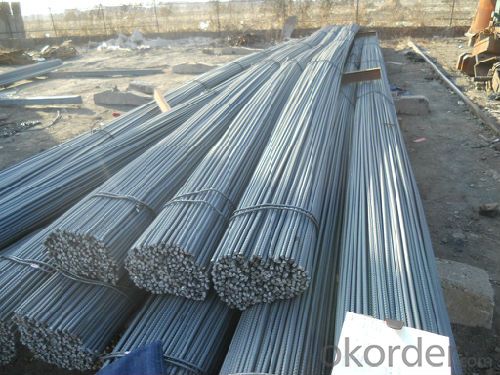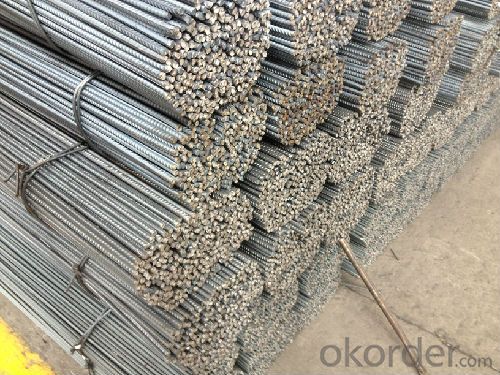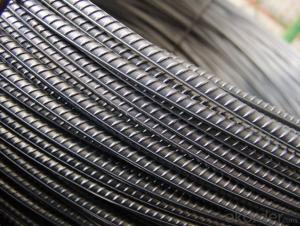Hot Rolled Steel Deformed Bar in Coils
- Loading Port:
- China Main Port
- Payment Terms:
- TT or LC
- Min Order Qty:
- 100 m.t.
- Supply Capability:
- 5000 m.t./month
OKorder Service Pledge
OKorder Financial Service
You Might Also Like
Product Description:
OKorder is offering Hot Rolled Steel Deformed Bar in Coils at great prices with worldwide shipping. Our supplier is a world-class manufacturer of steel, with our products utilized the world over. OKorder annually supplies products to African, South American and Asian markets. We provide quotations within 24 hours of receiving an inquiry and guarantee competitive prices.
Product Applications:
Hot Rolled Steel Deformed Bar in Coils are ideal for structural applications and are widely used in forest region, Mines, factories and construction sites laid of the place such as temporary transport line and light motorcycles with line..
Product Advantages:
OKorder's Hot Rolled Steel Deformed Bar in Coils are durable, strong, and wide variety of sizes.
Main Product Features:
· Premium quality
· Prompt delivery & seaworthy packing (30 days after receiving deposit)
· Can be recycled and reused
· Mill test certification
· Professional Service
· Competitive pricing
Product Specifications:
Manufacture: Hot rolled
Grade: HRB335,HRB400,HRB500
Certificates: ISO, SGS, BV, CIQ
Diameter:6mm-10mm
Packing: products are packed in coils and shipped by break bulk or containers
Grade | Technical data of the original chemical composition (%) | |||||||
C | Mn | Si | S | P | B | |||
HRB335 | ≤0.25 | ≤1.60 | ≤0.80 | ≤0.045 | ≤0.045 | >0.0008 | ||
Physics capability | ||||||||
Yield Strength(N/cm2) | Tensile Strength(N/cm2) | Elongation (%) | ||||||
≥335 | ≥490 | ≥16 | ||||||
FAQ:
Q1: Why buy Materials & Equipment from OKorder.com?
A1: All products offered byOKorder.com are carefully selected from China's most reliable manufacturing enterprises. Through its ISO certifications, OKorder.com adheres to the highest standards and a commitment to supply chain safety and customer satisfaction.
Q2: How do we guarantee the quality of our products?
A2: We have established an advanced quality management system which conducts strict quality tests at every step, from raw materials to the final product. At the same time, we provide extensive follow-up service assurances as required.
Q3: How soon can we receive the product after purchase?
A3: Within three days of placing an order, we will arrange production. The normal sizes with the normal grade can be produced within one month. The specific shipping date is dependent upon international and government factors, the delivery to international main port about 45-60days.
Images:


- Q:Are steel rebars suitable for use in extreme weather conditions?
- Indeed, steel rebars are well-suited for utilization in severe weather conditions. Renowned for its robustness and longevity, steel remains a favored option for construction materials, rebars included. When confronted with extreme weather phenomena like hurricanes, blizzards, or scorching temperatures, steel rebars have consistently demonstrated their ability to endure the forces and uphold their structural integrity. Moreover, steel rebars exhibit remarkable resistance to corrosion, a vital attribute in weather conditions characterized by excessive moisture or saltwater exposure. By employing steel rebars in construction endeavors, the assurance of safety and stability in structures is upheld, even amidst the most unforgiving weather circumstances.
- Q:Do steel rebars have any specific markings or codes?
- Yes, steel rebars typically have specific markings or codes to indicate their size, type, and grade. These markings are essential for identifying and ensuring the correct usage of rebars in construction projects.
- Q:Can steel rebars be used in wastewater treatment plant construction?
- Yes, steel rebars can be used in wastewater treatment plant construction. Steel rebars are commonly used for reinforcement in concrete structures, providing strength and durability to withstand the harsh conditions present in wastewater treatment plants.
- Q:How are steel rebars cut and bent on-site?
- Specialized tools and equipment are utilized on-site to cut and bend steel rebars. The process typically consists of the following steps: 1. Measurement: The rebars are measured according to the specified length and dimensions in the construction plans. This step is crucial to ensure precise and accurate cutting and bending. 2. Cutting: Various tools, such as manual rebar cutters, hydraulic shears, or portable electric cutters, are employed to cut the rebars. These tools are designed to make clean and precise cuts without damaging the rebars. The rebars are securely positioned, and the cutting tool is applied to the marked area to achieve the desired length. 3. Bending: Once the rebars are cut to the required length, they are bent using rebar benders. These machines possess different attachments and rollers to shape the rebars into the desired angle and radius. The rebars are cautiously positioned and secured in the bender, and the machine exerts force to bend them according to the specified shape. 4. Quality control: Following the cutting and bending stages, quality control checks are conducted to ensure that the rebars meet the required specifications. This may include visual inspections, measurements, and testing to verify the accuracy of dimensions and the quality of cuts and bends. It is important to note that skilled workers, such as ironworkers or steel fixers, typically assume responsibility for on-site rebar cutting and bending. They possess the expertise to interpret construction plans, utilize the appropriate tools, and guarantee the accurate cutting and bending of rebars to meet the project's requirements.
- Q:How do steel rebars affect the overall crack width of concrete structures?
- The crack width of concrete structures is affected by steel rebars in various ways. Primarily, the reinforcement provided by rebars strengthens the concrete, increasing its resistance to cracking. This reinforcement helps distribute the tensile forces within the concrete, preventing cracks from spreading and widening. When the concrete is subjected to tensile stress, the rebars bear a significant portion of the load, reducing stress on the concrete itself and minimizing crack formation. Furthermore, the use of rebars influences the spacing and size of cracks in concrete structures. Engineers can control the crack width by incorporating rebars at specific intervals and in appropriate sizes. The rebars act as barriers that limit crack width by resisting the tensile forces exerted on the concrete. This is especially important in structures exposed to heavy loads or external forces, as it preserves the structural integrity and durability of the concrete. Moreover, steel rebars impact the propagation of cracks in concrete structures. In the event of cracks, rebars prevent their further extension. They serve as anchors, holding the cracked sections of concrete together and preventing crack spread. This is essential for ensuring overall structural stability and reducing the risk of structural failure. To summarize, steel rebars play a crucial role in influencing the overall crack width of concrete structures. They enhance concrete strength, distribute tensile forces, regulate crack spacing and size, and inhibit crack propagation. By incorporating rebars into concrete structures, engineers can effectively manage and diminish crack formation and severity, ensuring the longevity and safety of the structures.
- Q:Can steel rebars be used in hospital construction?
- Yes, steel rebars can be used in hospital construction. Steel rebars are commonly used in construction projects, including hospitals, due to their strength, durability, and ability to reinforce concrete structures. They provide additional support and ensure structural stability, making them suitable for use in hospital buildings.
- Q:How are steel rebars bent or shaped to fit specific construction requirements?
- Steel rebars are bent or shaped to fit specific construction requirements using various methods such as manual bending, mechanical bending machines, or hydraulic bending machines. These techniques involve applying force to the rebar, which causes it to bend or take on a desired shape. The specific method used depends on the complexity of the required shape and the quantity of rebars needed.
- Q:How much is the weight of 6mm thread steel KG?
- Multiple objects can be hung, not only to see the hook itself, the bearing strength is not enough, the hook is nothing, even with the bearing down together is possible.
- Q:Are there any disadvantages to using steel rebars?
- Yes, there are some disadvantages to using steel rebars. Firstly, steel rebars can corrode over time, especially in environments with high moisture or exposure to chemicals, which can reduce their strength and durability. Additionally, steel rebars are susceptible to thermal expansion and contraction, leading to cracking in concrete structures. Moreover, steel rebars are heavy and can be challenging to handle and transport, making construction processes more labor-intensive.
- Q:What is the role of steel rebars in column and beam construction?
- Steel rebars play a crucial role in column and beam construction as they provide reinforcement, strength, and stability to the structure. In reinforced concrete construction, columns and beams are typically made of concrete, which is strong in compression but relatively weak in tension. This is where steel rebars come in. Rebars, also known as reinforcing bars, are long steel rods that are strategically placed within the concrete to counteract its weakness in tension. They are typically made of high-strength steel and are designed to withstand the tensile forces that occur in a structure. By adding rebars to the concrete, the resulting composite material can resist both compression and tension, making it much stronger and more durable. In column construction, steel rebars are placed vertically and tied together in a grid-like pattern. This reinforcement helps the column support the weight of the structure and resist vertical loads, such as the weight of the floors or roof above. The rebars also help to prevent the column from buckling or collapsing under these loads. Similarly, in beam construction, steel rebars are placed horizontally within the concrete beam. These rebars help the beam to resist bending and shear forces, which are common in structural elements that span across openings or support loads from above. By providing reinforcement, the rebars ensure that the beam remains stable and can safely bear the imposed loads. Overall, the role of steel rebars in column and beam construction is to enhance the strength, stability, and load-bearing capacity of the structure. They effectively improve the structural integrity of the concrete elements, allowing them to withstand the various forces and loads they will be exposed to throughout their lifespan. Without the presence of rebars, columns and beams would be much weaker and more susceptible to failure, compromising the safety and longevity of the overall structure.
1. Manufacturer Overview |
|
|---|---|
| Location | |
| Year Established | |
| Annual Output Value | |
| Main Markets | |
| Company Certifications | |
2. Manufacturer Certificates |
|
|---|---|
| a) Certification Name | |
| Range | |
| Reference | |
| Validity Period | |
3. Manufacturer Capability |
|
|---|---|
| a)Trade Capacity | |
| Nearest Port | |
| Export Percentage | |
| No.of Employees in Trade Department | |
| Language Spoken: | |
| b)Factory Information | |
| Factory Size: | |
| No. of Production Lines | |
| Contract Manufacturing | |
| Product Price Range | |
Send your message to us
Hot Rolled Steel Deformed Bar in Coils
- Loading Port:
- China Main Port
- Payment Terms:
- TT or LC
- Min Order Qty:
- 100 m.t.
- Supply Capability:
- 5000 m.t./month
OKorder Service Pledge
OKorder Financial Service
Similar products
New products
Hot products
Related keywords




























